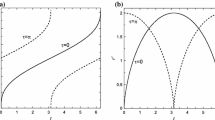Abstract
In a preceding paper (Kopal, 1969; in what follows referred to as Paper I) we introduced a new system of curvilinear coordinates-hereafter referred to as Roche Coordinates — in which spheres of constant radius in spherical polars have been replaced by surfaces of constant potential of a rotating gravitational dipole; while the angular coordinates are orthogonal to the equipotentials. In Paper I we established an explicit form of such a transformation, and related the Roche coordinates with polar coordinates (with which they coalesce in the immediate neighbourhood of each one of the two finite mass-points) in the plane case. The aim of the present investigation will be to generalize the definition of the Roche coordinates to three dimensions.
The opening Section 1 of this paper will contain a general outline of the proposed three-dimensional transformation; and in Section 2 details of this transformation will be explicitly worked out correctly to quantities of first order in superficial distortion — an approximation which should prove adequate in regions surrounding the two finite masses; while in Section 3 we shall evaluate (to this degree of accuracy) the metric coefficients of the respective transformation, and its direction cosines, in both polar and curvilinear coordinates. Section 4 will then contain a formulation of the fundamental equations of hydrodynamics in terms of the three-dimensional Roche coordinates; and their advantages for a treatment of certain classes of dynamical problems encountered in doublestar astronomy will be illustrated in the concluding Section 5 by an investigation of the vibrational stability of the Roche model. We shall show that this model is capable of performing free radial oscillations which remain barotropic only if its equilibrium form is spherical (i.e., in the absence of any external mass in the neighbourhood); but not if it is distorted to any extent by rotation or tides.
Similar content being viewed by others
References
Kitamura, M.: 1970,Astrophys. Space Sci. 7, 272–358.
Kopal, Z.: 1950,Proc. U.S. Nat. Acad. Sci. 36, 72–84.
Kopal, Z.: 1969,Astrophys. Space Sci. 5, 360–384.
Lamb, H.: 1932,Hydrodynamics, 6th ed., Cambr. Univ. Press, pp. 156–159.
Prendergast, K. H.: 1960,Astrophys. J. 132, 162–174.
Sterne, T. E.: 1937,Monthly Notices Roy. Astron. Soc. 97, 582–593.
Author information
Authors and Affiliations
Rights and permissions
About this article
Cite this article
Kopal, Z. The Roche Coordinates in three dimensions and their application to problems of double-star astronomy. Astrophys Space Sci 8, 149–171 (1970). https://doi.org/10.1007/BF00650878
Received:
Issue Date:
DOI: https://doi.org/10.1007/BF00650878




